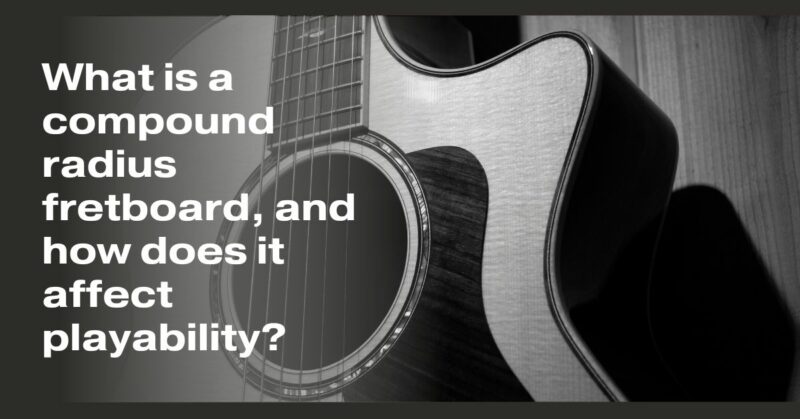The world of guitars is filled with diverse innovations aimed at enhancing playability and sound. One such innovation is the compound radius fretboard, a feature that has gained popularity among guitarists seeking versatile and comfortable instruments. In this article, we will explore what a compound radius fretboard is, how it works, and the ways it affects the playability of a guitar.
Understanding the Compound Radius Fretboard:
A compound radius fretboard is a design feature found on some electric guitars and basses. Unlike traditional fretboards with a consistent radius (usually between 7.25 inches and 16 inches), a compound radius fretboard gradually changes its curvature along the length of the neck. It typically starts with a more rounded radius near the nut (e.g., 7.25 inches) and progressively flattens out towards the higher frets (e.g., 12 inches or more).
How the Compound Radius Works:
The compound radius fretboard combines the best of both worlds by offering a comfortable, rounded shape near the nut for easy chord playing and transitioning into a flatter shape as you move up the neck for improved soloing and bending. This design concept results in several advantages for guitarists:
1. Chord Comfort Near the Nut: Near the headstock (the lower frets), the more rounded radius allows for easy chord playing and comfortable fretting. This curvature is conducive to forming chords without causing hand fatigue.
2. Flatter Radius for Soloing: As you move up the neck towards the higher frets, the radius gradually becomes flatter. This flatter section is excellent for soloing, bending strings, and achieving lower action without fretting out.
3. Improved Bending and String Bending: The flatter section of the compound radius makes it easier to execute precise string bends, making it a preferred choice for lead guitarists who rely on expressive bending techniques.
4. Reduced Fret Buzz: The flatter section can help reduce instances of fret buzz that may occur during aggressive playing, especially on lower frets.
Playability and Comfort:
The compound radius fretboard offers an enhanced playing experience by catering to different playing styles and techniques. Here’s how it affects playability and comfort:
1. Versatility: Guitarists can seamlessly switch between rhythm and lead playing without feeling hindered by the fretboard’s curvature. This versatility allows for more dynamic and expressive performances.
2. Reduced Hand Fatigue: The comfortable, rounded radius near the nut reduces hand strain when playing chords or complex fingerstyle patterns.
3. Enhanced Precision: The flatter section promotes accuracy in bending and note articulation, making it easier to execute fast runs and intricate solos.
4. Consistency Across the Neck: The compound radius offers a consistent feel across the entire fretboard, ensuring that your guitar’s playability remains steady from the first fret to the highest.
Choosing the Right Guitar:
When considering a guitar with a compound radius fretboard, it’s essential to try different guitars to find the one that suits your playing style and preferences. Keep in mind that while the compound radius offers versatility, some players may still prefer guitars with a consistent, traditional radius for specific genres or playing styles.
Conclusion: A World of Possibilities
The compound radius fretboard is a testament to the ongoing innovation in the world of guitars. It enhances playability and comfort, allowing guitarists to explore a wider range of techniques and musical styles. Whether you’re strumming chords near the nut or shredding solos on the higher frets, the compound radius fretboard opens up a world of possibilities, making it a valuable addition to the arsenal of any guitarist seeking versatility and dynamic performance.


